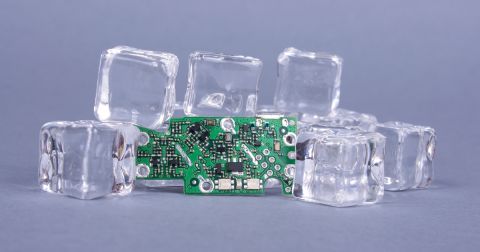Symmetric Stripline Inductance or Impedance Calculators and Formulas
In a previous article, we looked at the inconsistencies that can arise when using different calculators to compute the impedance of surface and embedded microstrip traces. Many of the same issues mentioned in the previous article apply to stripline impedance calculators. Symmetric striplines are easier to address than asymmetric striplines, both numerically and analytically. Here, we’ll give a short comparison of the various impedance formulas and calculators for symmetric striplines.
The IPC Formulas and Wadell’s Method
Just as was the case with microstrip impedance calculators, stripline impedance calculators tend to rely on either the IPC-2141 formulas or on Wadell’s equations. One should always check carefully whether a calculator implements these equations under the appropriate approximations. To get started, the symbols used in the equations in this article correspond to the geometry shown below:
Symmetric stripline geometry
Many calculators divide the equations into a series of approximations for various limits on the geometric parameters in the above figure. These equations can be found using Wadell’s methods. Under specific (not mutually exclusive) approximations, the following equations define the impedance of a stripline:
Stripline impedance equation for narrow strips
For wide striplines, the above equation reduces to the following equation in terms of a fringing capacitance factor:
Stripline impedance equation for wide strips
The above solution is defined explicitly in the IPC-2141 standards. In general, these equations produce ~1% error with experimental results, which is much higher accuracy than the IPC standard equation for a microstrip transmission line. This is one area where the IPC-2141 standard definitely uses the right definition.
A good calculator will automatically distinguish between the relevant limits and apply the right equation based on the user’s input. Others will assume that the user is referring to a narrow or wide stripline, but it will not explicitly state the applicability of the calculator. Always be sure to check whether the calculator defines one of the above two limits when computing the impedance of a stripline.
Some calculators directly emulate one another, thus might contain the same typographical errors. There are other equations that are defined for stripline impedance calculators that are only valid under specific approximations, and they are really a reduction of the equations shown above. It is the opinion of the author that these other equations should be avoided.
An alternative solution in the limit T = 0 can be written in terms of elliptical integrals of the first kind. Developers interested in creating their own stripline calculators can easily implement a standard numerical algorithm for evaluating this integral. Interested readers are referred to Cohn’s original paper on the subject for this equation.
The Relation to Transmission Lines
One aspect that is not often addressed—both with microstrips and striplines that act as transmission lines—is whether the two formulas are actually consistent and which formulas should be used. In fact, there isn’t really a controversy between the equations for the characteristic impedance of a transmission line based on circuit analysis and the impedance defined in terms of Wadell’s method. The issue with using the transmission line equation from circuit analysis comes from calculating the equivalent parameters in the lumped transmission line model.
As a refresher, the impedance of a transmission line is related to the per-unit inductance and capacitance of a transmission line. Note that this is applicable for a microstrip or stripline transmission line. In general, losses are considered as copper conductors have some small resistance, and the substrate provides some residual conductance between the transmission line and its reference plane. The basic equation for the single-ended impedance of a lossy transmission line is shown below.
Transmission line impedance equation determined from circuit analysis
This equation is derived from an equivalent lumped element circuit model for a transmission line. Note that the equivalent capacitance and inductance in this equation are related to the geometry of the transmission line and the material properties of the conductor and substrate. This is not explicitly stated in every derivation of stripline and microstrip impedance equations for a number of reasons.
First, the exact path of the current in the return plane determines the loop inductance for the equivalent circuit, while the transverse distribution of current in the reference plane determines the capacitance. The transverse current distribution is also related to the substrate conductance. Assuming that the current distribution is uniformly distributed in the reference plane and that the current return path follows exactly along the conductor are not always correct. Therefore, using a geometric approximation is not the best way to calculate the lumped capacitance and inductance of the transmission line.
Some calculators will allow you to input the equivalent inductance and capacitance per unit length, as well as the conductor’s resistance, substrate conductance, and signal frequency when calculating the impedance of a stripline or microstrip transmission line. However, these values cannot be known priori and require accurate measurements. Therefore, the approach outlined by Wadell is a more accurate approach for calculating the impedance of a stripline or microstrip.
If you are looking for a useful resource for designing transmission lines with rectangular or circular cross-section, this IEEE paper provides a good starting point and some simple formulas. The formulas in this paper are derived under reasonable approximations and are consistent with experimental results in PCBs.
With high speed and high frequency controlled impedance design being so important and a major time saver, you need design tools that allow you to define the right impedance equation for your stripline configuration. Altium Designer includes a layer stack manager and impedance calculator with an extensive stackup materials library. You’ll have the tools you need to constrain your geometry to the dimensions required to control impedance throughout your PCB.
If you’re interested in learning more about Altium Designer, you can contact us or download a free trial and get access to the industry’s best layout, routing, and simulation tools. Talk to an Altium expert today to learn more.












 Back
Back